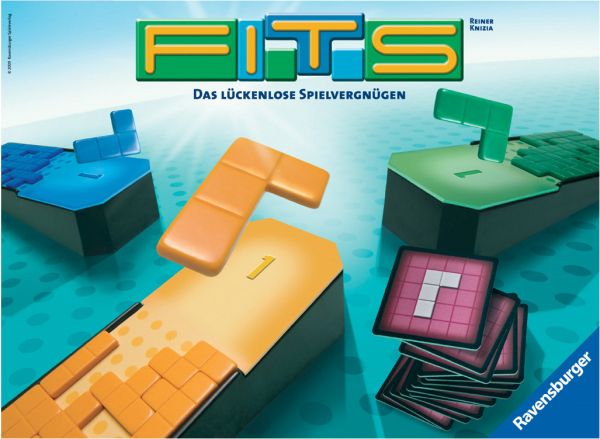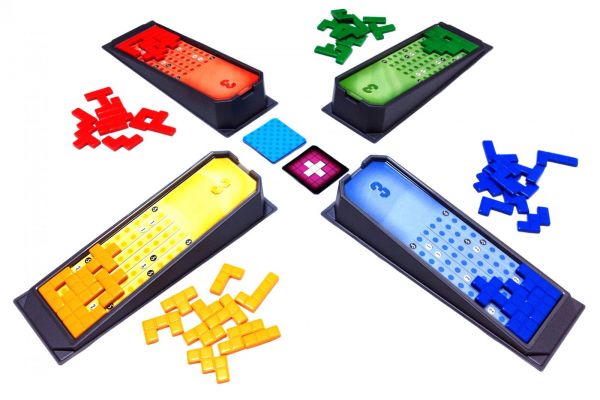Tile-Fitting Fun: A Review of FITS

No, it's not Tetris, but it's remarkably similar. FITS (Fill-In-The-Spaces) is a board game by Ravensburger that brings the challenge of tile-fitting games like Tetris to the table top. It introduces some competitive play and certainly challenges spacial reasoning. But is it fun?
Gameplay
In FITS, each player receives a ramp, 2 double-sided game boards, and 16 game tiles of various shapes and sizes. The object of the game is to score the most points over 4 rounds of play. Each round uses a different game board that introduces different scoring methods with increasing difficulty. Game boards are placed on the ramp and covered with a transparent cover.
At the beginning of a round, each player is dealt a card that determines which tile he will start with. The tile is positioned over the columns at the top of the game board, then slid down the board until it can go no further — the ridges on the board cover help guide it into place. Tiles can be rotated or flipped in any direction prior to placing them on the board. After the initial tile, additional cards are drawn one-by-one and all players place the corresponding tile of their color.
When placing a tile, it must slide straight down — it cannot be moved left or right to fill in gaps. In this way, if a tile hangs over the edge of a column, nothing else can be placed underneath it. If a player chooses not to place a tile, he sets it aside (and it will not get played for the rest of the round).

Each game board contains a certain number of dots. Players will want to cover up as many dots as they can, since any dots that remain visible at the end of the round are worth -1 point. Additional scoring methods differ for each round. For the first round, each completed row is worth +1 point. For the second round, special dots that remain visible are worth up to +3 points. For the third round, special dots that remain visible are worth either -5 points or up to +3 points. For the final round, there are several pairs of special dots (containing distinct shapes) — at the end of the round, a pair of dots is worth +3 points if they are both visible, or -3 points if only one of them is visible.
After all 4 rounds, players add up their total points and the highest score wins.
Review
FITS is a tactile tile-fitting game that is surprisingly unique and challenging. While Tetris is the first thing that comes to mind upon seeing this game, there are quite a few differences that make it fresh, even for the experienced Tetris player. First, the pieces vary widely in their sizes and shapes, making them quite difficult at times to place effectively. Second, it is not permitted to shift the tiles left and right to fill in gaps, which makes each placement decision even more important. Third, the goal is not always to fill complete rows — keeping certain spaces open while filling in others changes up the strategy.
The fact that the game progresses in difficulty adds to the suspense, especially for a player who starts out strong. There is certainly no guarantee that a player in the lead will stay in the lead until the end — scores are usually surprisingly small and swings can happen fairly easily.
Even after a solid start to a round, the remainder of the round can turn sour if poor placement decisions are made or certain tiles come into play when they are unwanted. The plus-shaped tile, in particular, tends to cause a lot of groans when it comes into play. Fortunately, players may choose to set aside any unwanted tile with the understanding that they may not have enough tiles available to cover all of the dots at the end of the round. This offers an interesting trade-off that enhances gameplay.
On the downside, there is no interaction in this game. While players are competing with each other, they are focused on their own boards, with no reason whatsoever to worry about what the other players are doing. While this isn't ideal, it can be good for some situations. For instance, we have found this to be a great family game because it allows our two-year-old to play with her own "puzzle pieces" without messing up the game for everyone else — we just have to be very careful not to lose the pieces!
The fact that players begin with a different piece each round guarantees that each board will be different, but also puts each player on a different playing field. Can the victor feel as good about his victory if everyone else had a different piece to start with? This is not a problem for most players, but competitive players may want to begin with the same piece in order to ensure fairness.
While there certainly is strategy to the game, the final scores may come down to the luck of the draw (i.e., the order the pieces are played). Groups who want to plan more effectively and reduce frustration might want to turn over an additional card (always keeping 2 cards visible instead of 1) so they know what piece is coming next.
FITS is an interesting casual game that works quite well for solitaire play and can be enjoyable for groups who don't need a ton of interaction. People of all ages can get into it, and even little kids can enjoy playing with the pieces without ruining the game for the adults. A few simple house rules can improve the game for more competitive or strategic players.
Pros: Progressive difficulty across multiple rounds, different scoring methods to keep things fresh, good for families with varying ages
Cons: No interaction, house rules may be necessary for some groups
Disclosure: we received a complimentary review copy of this game.







